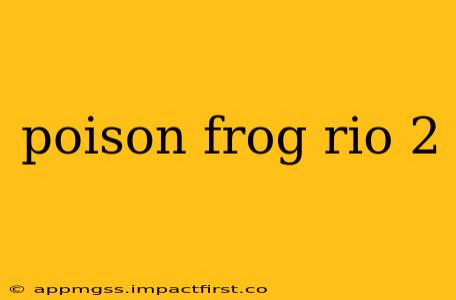The vibrant poison dart frog, a captivating character in the animated film Rio 2, brings both entertainment and a crucial message about conservation to the screen. While fictionalized for the movie, the portrayal raises awareness about the real-life challenges these amphibians face in the Amazon rainforest and beyond. This article delves into the fascinating world of poison dart frogs, their representation in Rio 2, and the critical conservation efforts needed to protect them.
What Kind of Frog is Nico in Rio 2?
Nico, the charming poison dart frog in Rio 2, is depicted as a vibrant blue poison dart frog. While many species boast striking colors, no single species perfectly matches Nico's vivid blue. The film likely took creative liberties, drawing inspiration from the diverse array of colors and patterns found within the Dendrobatidae family. This artistic license serves to highlight the beauty and diversity of these fascinating creatures. The important aspect is that Nico represents the general characteristics and vulnerability of these rainforest inhabitants.
Are Poison Dart Frogs Poisonous in Real Life?
Yes, many species of poison dart frogs are indeed poisonous, though not all. The toxicity varies greatly depending on the species and their diet. Their potent toxins, primarily batrachotoxins, are derived from the insects they consume. The frogs don't produce these toxins themselves; they accumulate them from their food sources. This makes their diet crucial to their toxicity. The intensity of their poison can be powerful enough to be dangerous to humans, highlighting the importance of handling them with extreme caution. However, it's important to emphasize that not all species are equally toxic, and the level of toxicity can even fluctuate within a species depending on several factors.
What Do Poison Dart Frogs Eat?
The diet of poison dart frogs primarily consists of small invertebrates, such as ants, termites, beetles, and other arthropods. The specific diet varies depending on the species and their habitat. These insects provide the frogs with the necessary nutrients and, in some species, the batrachotoxins that make them poisonous. Their hunting techniques are typically ambush predation, waiting patiently for unsuspecting prey to wander within striking distance.
What is the Conservation Status of Poison Dart Frogs?
Many species of poison dart frogs face various threats, impacting their conservation status. Habitat loss due to deforestation is a major concern. The Amazon rainforest, their primary habitat, is continually being cleared for agriculture, logging, and mining. This destruction directly impacts their populations, shrinking their available habitat and isolating populations. Pollution, climate change, and the illegal pet trade also contribute significantly to the decline of many species. This makes conservation efforts increasingly urgent to safeguard these magnificent creatures and their ecosystems.
How are Poison Dart Frogs Important to Their Ecosystem?
Poison dart frogs, despite their small size, play an important role in the delicate balance of the rainforest ecosystem. As predators, they control populations of insects and other invertebrates. Their presence helps maintain the biodiversity and stability of their environment. Additionally, their vibrant colors and diverse species contribute to the overall richness and beauty of the rainforest ecosystem.
Conclusion: Beyond the Animation
Rio 2 successfully introduced a captivating character that raises awareness of the vibrant world of poison dart frogs. However, the film also underscores the critical need for conservation efforts to protect these amazing amphibians and their threatened habitats. Understanding the threats they face—habitat loss, pollution, and the illegal pet trade—is crucial to developing effective strategies to ensure their survival for generations to come. Continued research, responsible ecotourism, and dedicated conservation initiatives are all vital components in the fight to preserve these beautiful creatures and the diverse ecosystems they call home.
